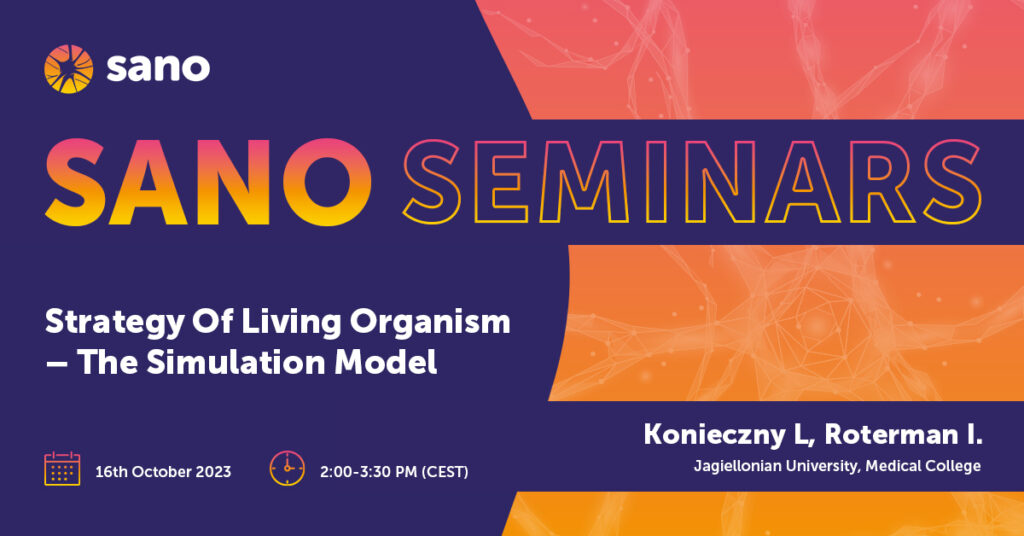108. Strategy Of Living Organism – The Simulation Model
Konieczny L, Roterman I. – Jagiellonian University, Medical College
Abstract
The organisation of functioning of Human body – the most complex system on our Planet – is expected to be available for computer simulation. Availability of such system is not only the source of information as to the status of the system in particular moment. It could be the tool for In Silico experiments. The aim-oriented insertion of the local demage in activity may inform as to the nature of its consequences. The results of introduced damage of particular element may be local and limited to close neighbourhood. Others – especially when based on communication disorder – may reveal the surprisingly long-distance consequences.
The model for computer simulation is presented. It may applied to any living organism as well to human body in particular. Such tool is desperately expected for pathological processes recognition especially for rare diseases.
Model construction
The main characteristics of living organism are:
- Organism is the open system – many signals of chemical and of other characters are adopted by living organism
- Despite of this oppennes the organism is keeping the stability – called in biology – homeostasis
It is only one solution to satisfy these two conditions: the automatic control in form of the network of negative feedback-loops.
The proposal to construct the system of mutual relations of negative feedback loops representing certain processes passing in the organism is presented.
The model is in contrast to other proposals basing on the structural unit which is one single protein. The structural-functional unit of the proteom construction in presented model is one negative feedback loop. The role of proteins participating in the activity of such loop is very well defined. This identification distinguishes the specificity of each role played by particular protein like receptor or effector. Different numer of proteins participates in one loop construction. It depends on the effector activity.
Two communication systems are proposed for loop-to-loop contacts and mutual influences. One of them is addressed to effector, the second one to receptor. The first one is responsible for delivering expected compound (effector knows „How” to run particular process”) and second – keeeping the stable level of concentration – thus responsibility for „How much” ? Other proteins participation in the circle is the role of messenger for receptor-effector communication. Other prteins participating in the one negative feedback loop construction depends also on necessary enhancement of the signal as well as the proteins responsible for transport – like membrane-anhored proteins to transfer the signal molecules.
The number of protein engaged in one negative feedback loop construction depends mainly on the process performer by effector. In case of effector activity in form of cell division, the number of proteins engaged is quite large.
The signalisation addressed to receptor is of the order character. It pushes the receptor to increase the level of stability in case of higher consumption of the product of particular loop. This signal is as long active as long it reaches the receptor. In case of signal silencing, the loop goes back to standard parameters. The effector addressed signal represents the form of more or less stable and permanent delivery of substrates.
The basis for presented model is described in details in [1-4]. The test version for limited numer of units is available at https://nfs.sano.science, in which the user can model interconnected systems and their interactions, depending on system parameters – such as receptor sensitivity, effector reaction speed or the time it takes for signals to travel between the receptor and the effector. This service allows perfoming the In Silico experiment. User may change arbitrarily selected parameter receiving the feedback visualising the characteristics of the system in new, changed conditions including total demage of the regulation system.
References:
- Konieczny L, Roterman I, Spolnik P. Systems Biology – Functional strategies of living organism Springer 2014
- Konieczny L, Roterman I, Spolnik P. Biologia Systemów- Strategia działania organizmu żywego – PWN 2021.
- Wach J.; Bubak M.; Nowakowski P.; Roterman I.; Konieczny L.; Chłopaś K. Negative feedback inhibition – Fundamental biological regulation in cells and organisms. In: Simulation in medicine – Pre-clinical and Clinical Applications. Ed: Irena Roterman-Konieczna, Walter de Gruyter GmbH, Berlin/Boston 2015, pp. 31-56.
- Konieczny L, Roterman I, Spolnik P. Systems Biology – Functional strategies of living organism – electronic version accessible in Internet – available soon
About the authors
Prof. Dr. Irena Roterman-Konieczna – head of Department of Bioinformatics and Telemedicine at Jagiellonian University – Medical College 2000-2020. IR-K educated in theoretical chemistry is involved in bioinformatics – structure and protein folding and systems biology. She is the author of the fuzzy oil drop model for protein folding simulation taking into account the active participation of water environment. This model appears to be able to identify the biological activity of protein as well as the recognition of the mechanism of amyloidosis [From globular proteins to amyloids – Ed IR-K, Elsevier 2020]. The proposal to treat the negative feed-back system as the functional-structural unit to construct the proteome to keep the homeostasis is expressed in Systems Biology – Ed. Leszek Konieczny, IR-K Springer 2012. IR-K is the author of educational program addressed to medical students in “Simulation in Medicine” – two volumes: Ed IR-K Walter de Gruyter 2015 and 2020. IR-K is also the Chief Editor of the journal “Bio-Algorithms and Med-Systems” published since 2000. The journal is focused on implementation of programming in medicine for the whole spectrum from basic research to practical medicine.
Prof. emeritus Leszek Konieczny, MD, is Professor of Biochemistry at the Medical College of Jagiellonian University, Poland. His background is in medicine and his research focuses on immunochemistry and target-oriented drug transport. He is the author of numerous scientific papers in the field of protein structure, function and immunochemistry. He teaches biochemistry to medical students and has authored several textbooks on systems biology and protein structure.


